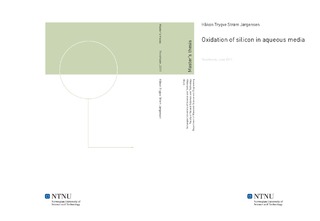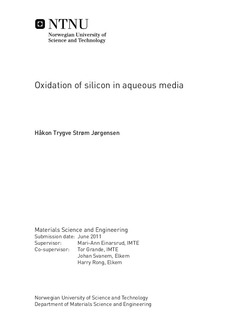| dc.description.abstract | Silicon is used in the production of various ceramic products. As the solar industry is advancing, the need for reusable crucibles for the casting of solar grade silicon has arisen. One idea is to produce silicon nitride crucibles by slip casting. During slip casting, silicon powder is mixed with water at high alkaline conditions to ensure good dispersion of the powder and a stabilized slip. This may lead to oxidation of the silicon and the evolution of hydrogen gas. The hydrogen evolution introduces porosity in the final product, thereby ruining the mechanical properties. Gaining knowledge on how to inhibit the oxidation of silicon in slurries would therefore prove valuable for producing defect-free silicon based ceramics.In this thesis the main objective is to gain knowledge about the oxidation of silicon in aqueous media, emphasizing on the formation of oxides with respect to initiation point, initiation time and characterizing of the oxide. Silicon powder and coarse silicon particles delivered by Elkem was oxidized in a purpose built apparatus. The effects on the powder and the coarse particles were examined by the several techniques, including among other: SEM, Colorimetry, HR ICP-MS and LECO. The mechanical properties of oxidized single crystal and polycrystalline silicon were also investigated, using nanoindentation.The most important results, indicates that the oxidation of silicon results in formation of silica and hydrogen gas evolution. Firstly silicic acid is formed until the solubility limit is reached. Further oxidation leads to silicic acid condensing to form; colloidal silica which adsorbs on the silicon particles and dispersed colloidal silica in the suspension. The oxide layer formation on the coarse silicon particles were studied and confirmed using SEM. The oxide is the result of silicic acid condensing to form silica and adsorbing on to the surface of the silicon. Initiation points for the oxidation were not found. A more controlled oxidation is needed and the study of the oxide layer must be performed with high resolution techniques like Atomic Force Microscopy and/or Auger Electron Spectroscopy.There were some problems related to reproducing the results with respect to the hydrogen evolution from the silicon powder. Storage of the powder seemed to be a key factor as the powder behaved differently from one week to another. Storage in a desiccator for two weeks lead to earlier and more intense hydrogen evolution. Any reasonable cause for this was not found, and is subject for further investigations. The initiation time for hydrogen evolution was therefore difficult to determine, as it is dependent on unknown parameters.Nanoindentation was found to be a useful technique for studying the mechanical properties of oxidized silicon. The results indicated that the single crystal samples were homogeneous with respect to mechanical properties, as each of the indents of the respective samples produced more or less the same value. The E-modulus for the oxidized single crystal sample was about 10 GPa lower than for the unoxidized sample, the hardness was not affected. The results for the polycrystalline sample is more difficult to interpret, but nanoindentation indicates that the oxidized sample is not as homogeneous as the single crystal particles with respect to mechanical properties. The hardness was equal to the single crystal samples, and the E-modulus was close to that of the unoxidized single crystal sample. | nb_NO |

